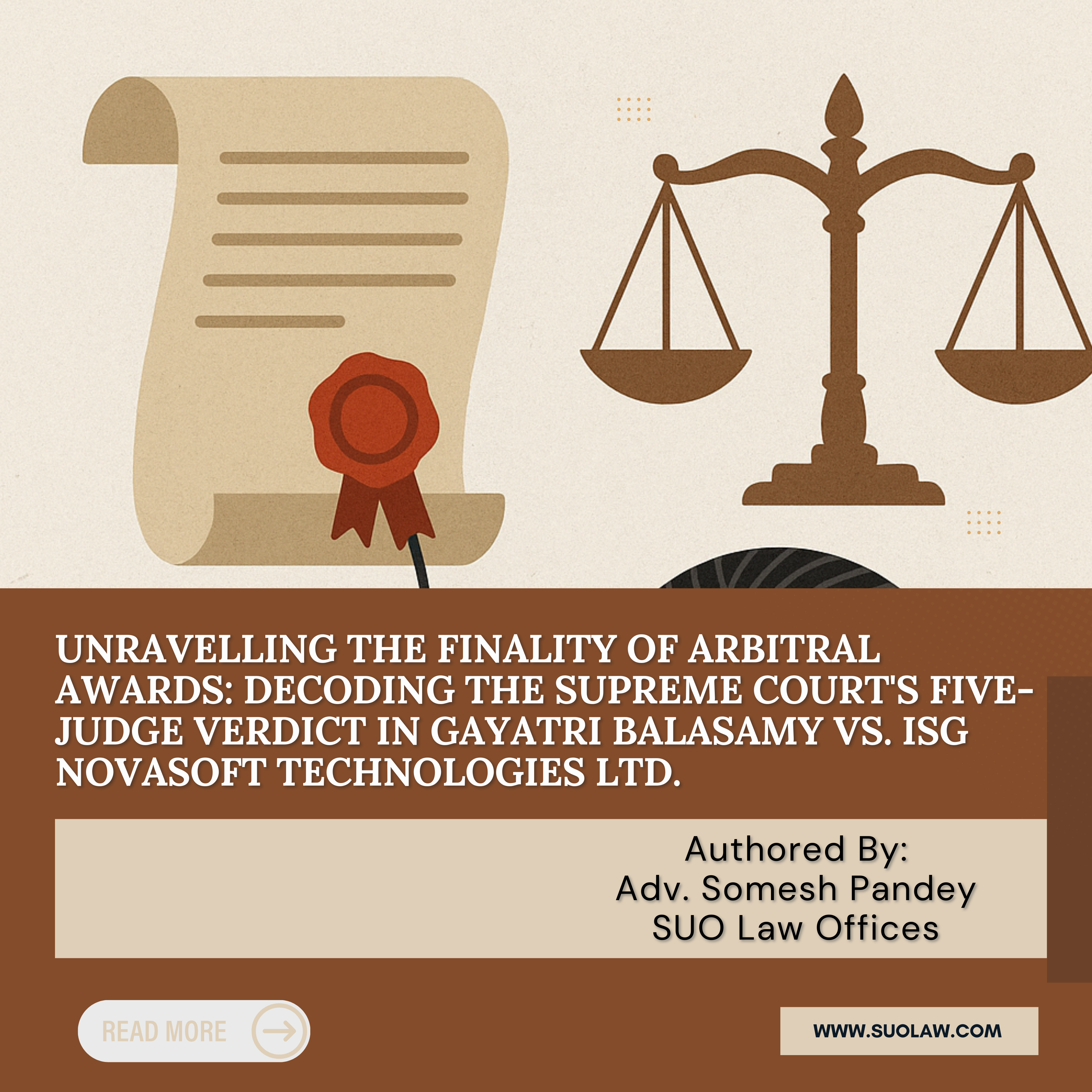UNRAVELLING THE FINALITY OF ARBITRAL AWARDS: DECODING THE SUPREME COURT’S FIVE-JUDGE VERDICT IN GAYATRI BALASAMY VS. ISG NOVASOFT TECHNOLOGIES LTD.
On April 30, 2025, a five-judge Constitution Bench of the Supreme Court of India delivered a landmark judgment in Gayatri Balasamy vs. ISG Novasoft Technologies Ltd., fundamentally reshaping the contours of judicial intervention in arbitral awards under the Arbitration and Conciliation Act, 1996. In a 4:1 majority decision, authored by Chief Justice Sanjiv Khanna, the Court held that courts possess a limited power to modify arbitral awards under Sections 34 and 37 of the Act. This ruling, while aimed at promoting efficiency and reducing litigation, introduces interpretive complexities that may have far-reaching implications for arbitration practice in India. This article explores the judgment’s key findings, its alignment with international arbitration norms, potential challenges, and its impact on the arbitration landscape.
The majority’s reasoning: A limited power to modify
The majority judgment establishes that Section 34, which empowers courts to set aside arbitral awards, implicitly includes the authority to modify them in specific circumstances. The Court reasoned that the power to set aside an award encompasses the ability to partially set it aside, provided the valid and invalid portions are severable and not intrinsically intertwined. The Act’s silence on modification does not constitute a prohibition, as this power is incidental to the court’s authority to set aside awards and is necessary to advance the Act’s objectives of efficiency and fairness. The majority outlined specific scenarios where modification is permissible:
1. When denying modification would cause significant hardship, escalate costs, or lead to unnecessary delays.
2. When modification avoids forcing parties into fresh arbitration to affirm a decision that the court could readily make.
3. To correct clerical, computational, or typographical errors that are “apparent on the face of the record.”
4. To alter post-award interest under Section 31(7), a provision unique to Indian law, allowing courts to scrutinize interest awards against statutory standards.
The Court emphasized that modification is distinct from appellate review. Modifications must be indisputable, with no uncertainty regarding their appropriateness. For instance, correcting “manifest errors” such as typographical mistakes does not require a merits-based evaluation. However, the undefined term “manifest errors” introduces ambiguity, potentially expanding judicial review into factual appreciation under the guise of error correction.
Additionally, the majority upheld the discretionary power to remand awards but cautioned against its use in cases involving serious omissions, patent illegality, or substantial injustice, where remand would lead to undue costs or delays. The Court also noted that under Article 142 of the Constitution, the Supreme Court may modify awards to do “complete justice,” but this power does not extend to rewriting awards.
The dissent: A defence of arbitral finality
Justice K.V. Viswanathan’s dissenting opinion rejected the notion of a judicial power to modify awards under Section 34. He argued that implying such a power undermines the Act’s core objective of minimizing judicial intervention, which is central to the arbitration process’s ethos. He further cautioned that this approach could complicate the enforcement of awards under the New York Convention on the Recognition and Enforcement of Foreign Arbitral Awards, 1958, as modified awards may create discrepancies between the original award enforced abroad and the altered version in India.
Guardrails and ambiguities
The majority sought to establish strict boundaries for modification, limiting it to severable portions of an award and cases where it prevents injustice, delay, or excessive costs. However, the judgment leaves several questions unanswered. Terms like “furthering the ends of justice” and “errors apparent on the face of the record” are open-ended, lacking clear definitions or tests to determine what constitutes “hardship” or “unnecessary delay.” Similarly, the distinction between valid and invalid clauses remains unclear, particularly in cases involving consolidated damages awards. For example, if a tribunal awards ₹1 crore for delay damages but evidence supports only ₹30 lakhs, modifying the award to reflect the lower amount requires a merits-based inquiry, an action explicitly outside Section 34’s scope. Such scenarios risk courts exercising appellate functions under the guise of modification, undermining arbitral finality.
The judgment also fails to clarify when courts should opt for remand over modification. While modification may be more expeditious, remand involves additional proceedings before the tribunal, subject to further judicial scrutiny. Courts may prefer modification to avoid protracted processes, but extensive reconsideration of facts or merits may necessitate remand, leaving practitioners to navigate this distinction in practice.
International practice and the New York Convention
The majority’s assertion that its ruling aligns with international practice is debatable. In arbitration friendly jurisdictions like the UK and Singapore, courts have limited powers to modify awards, but these are expressly provided by statute, offering clarity and defined limits. For instance, the UK’s Arbitration Act explicitly allows modifications for clerical errors or to clarify ambiguities, with strict guardrails. In contrast, the Indian Act lacks such provisions, and the Gayatri Balasamy judgment relies on implied powers, which may lead to inconsistent application.
The judgment’s implications for enforcement under the New York Convention are significant. Unlike Indian law, where a Section 34 challenge does not automatically stay enforcement, the Convention allows awards to be enforced abroad without confirmation by the seat court. If an Indian court modifies an award, discrepancies may arise between the original award enforced internationally and the modified version in India. The English Arbitration Act addresses this by treating modified awards as part of the original, but no such provision exists in Indian law, creating potential enforcement challenges.
The Arbitration and Conciliation Bill, 2024
India’s proposed Arbitration and Conciliation Bill, 2024, does not currently provide for judicial modification of awards. The Gayatri Balasamy judgment may prompt amendments to incorporate recommendations from the T.K. Viswanathan Expert Committee Report, which could clarify the scope of modification powers. Such changes would align India’s arbitration framework more closely with international standards, providing statutory clarity absent in the current Act.
The path forward: opportunities and risks
The Gayatri Balasamy judgment reaffirms arbitration’s promise of speed by allowing courts to modify awards in limited circumstances, avoiding protracted re-arbitration or litigation. This is particularly beneficial for awards where severable errors can be corrected without undermining the tribunal’s findings. The ruling may also encourage parties to opt for arbitration, knowing courts can intervene to protect their interests without nullifying entire awards. However, the judgment risks increasing Section 34 challenges by creating new avenues for litigation. The ambiguity surrounding “manifest errors” and severability could lead courts to encroach on arbitral tribunals’ fact-finding authority, contrary to the Act’s intent. The ruling on post-award interest may also prompt challenges where tribunals have not granted interest, further complicating proceedings.
Conclusion
The Gayatri Balasamy judgment marks a pivotal moment in Indian arbitration law, granting courts a limited power to modify arbitral awards under Sections 34 and 37. While aimed at enhancing efficiency and fairness, the ruling introduces interpretive uncertainties that may fuel litigation and challenge arbitral finality. Its alignment with international practice is questionable, and enforcement issues under the New York Convention remain unresolved. As courts begin to apply this precedent, practitioners will closely watch how the balance between judicial intervention and arbitral autonomy is struck. The judgment’s legacy will depend on whether courts exercise this power with restraint or allow it to become a gateway for broader judicial review.
Authored by
Adv. Somesh Pandey

